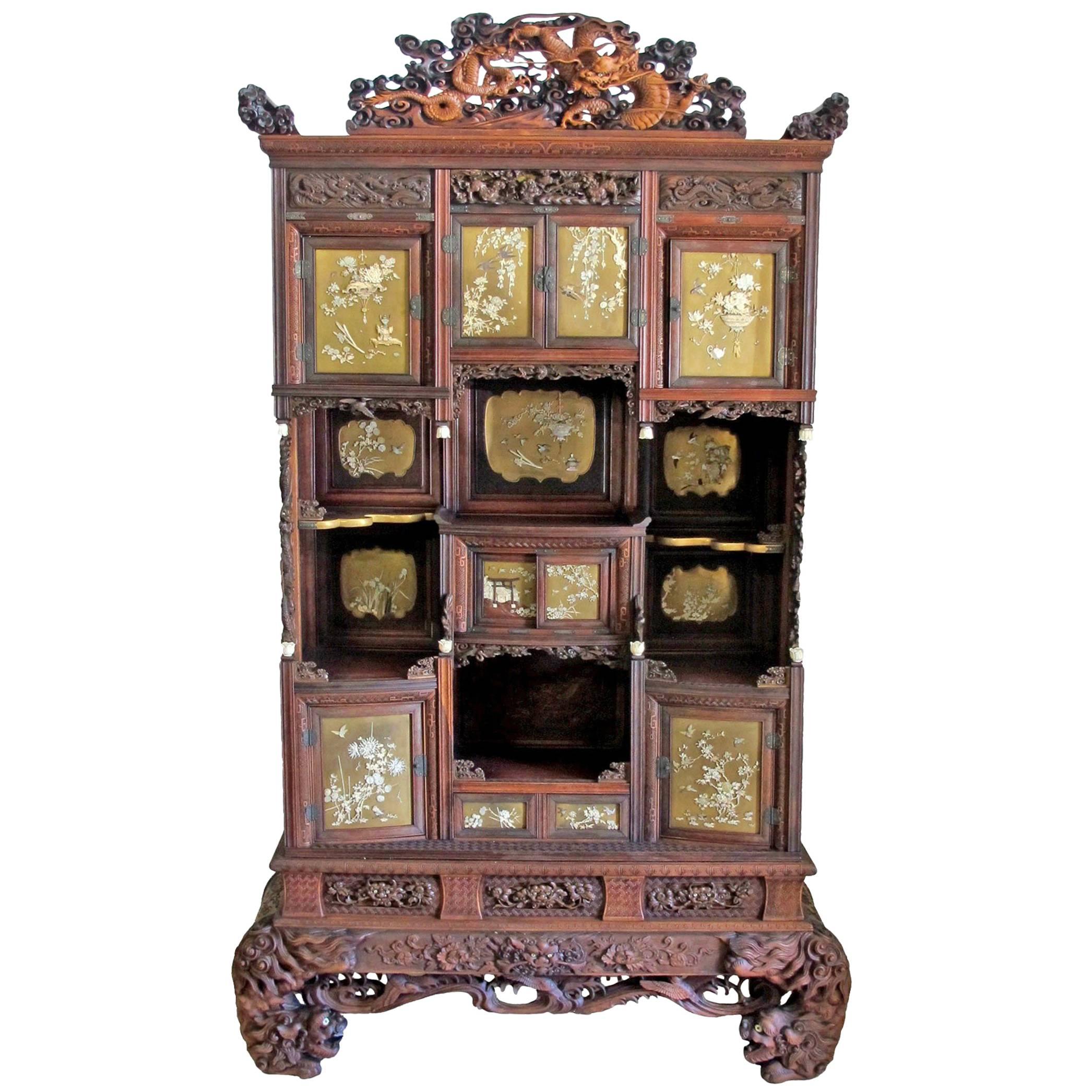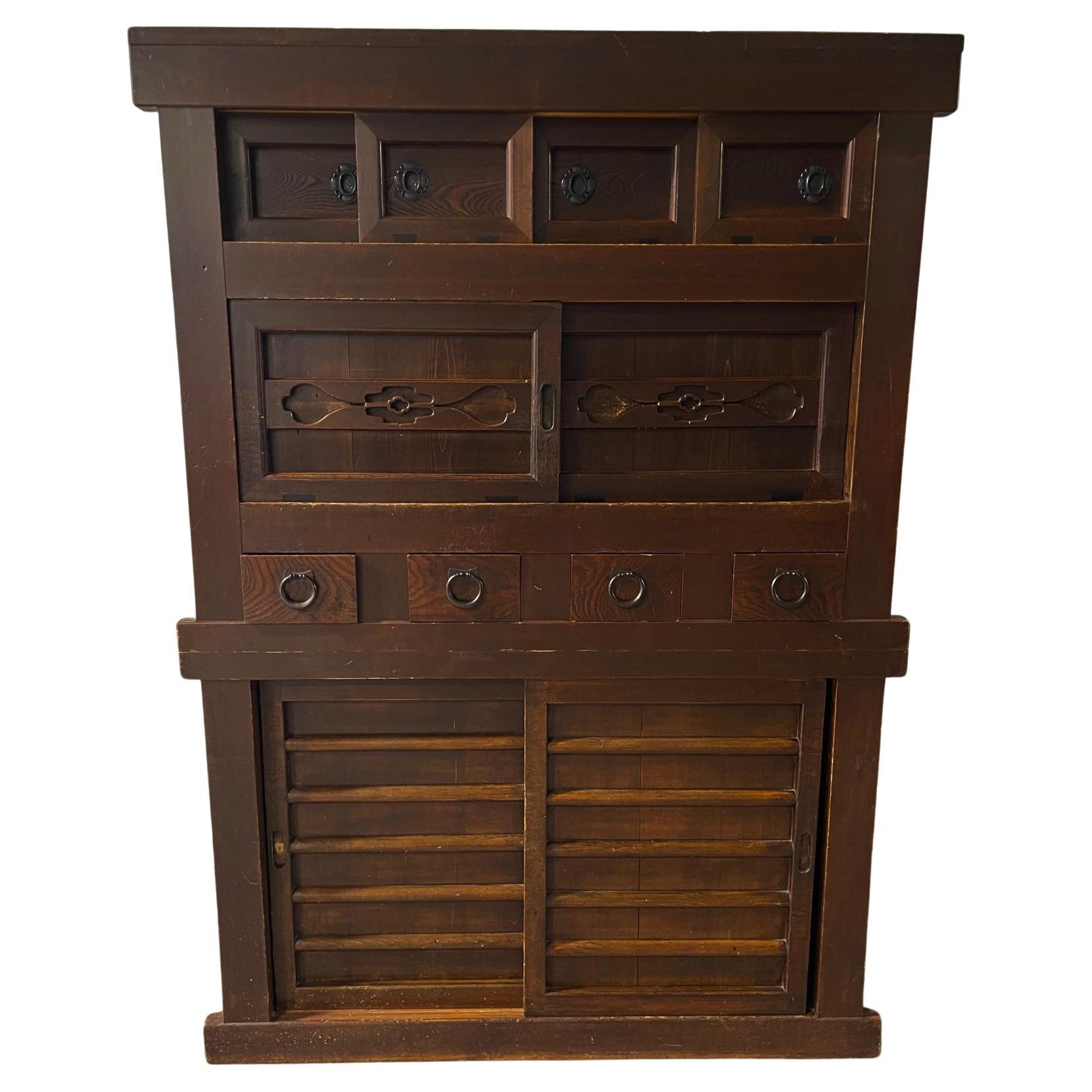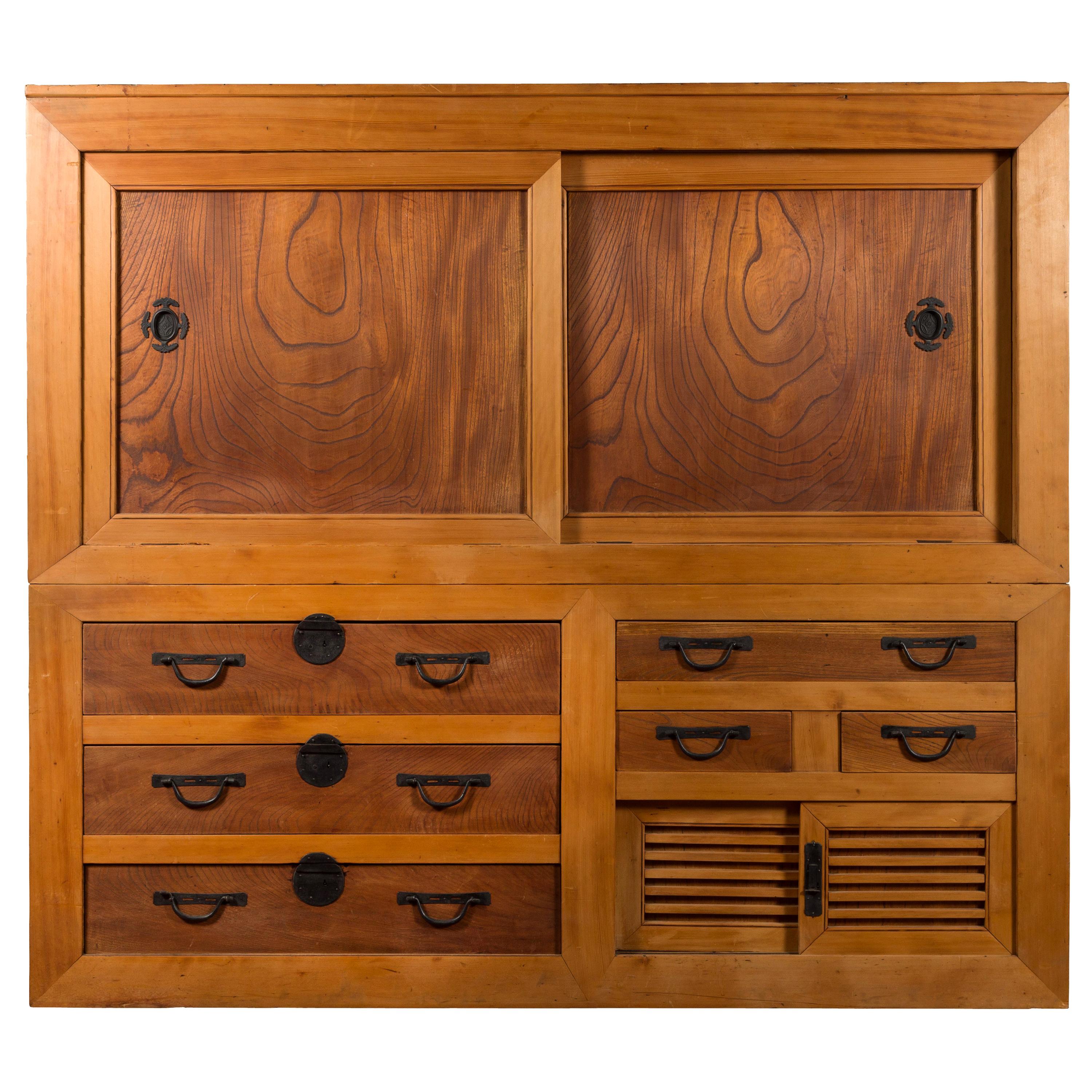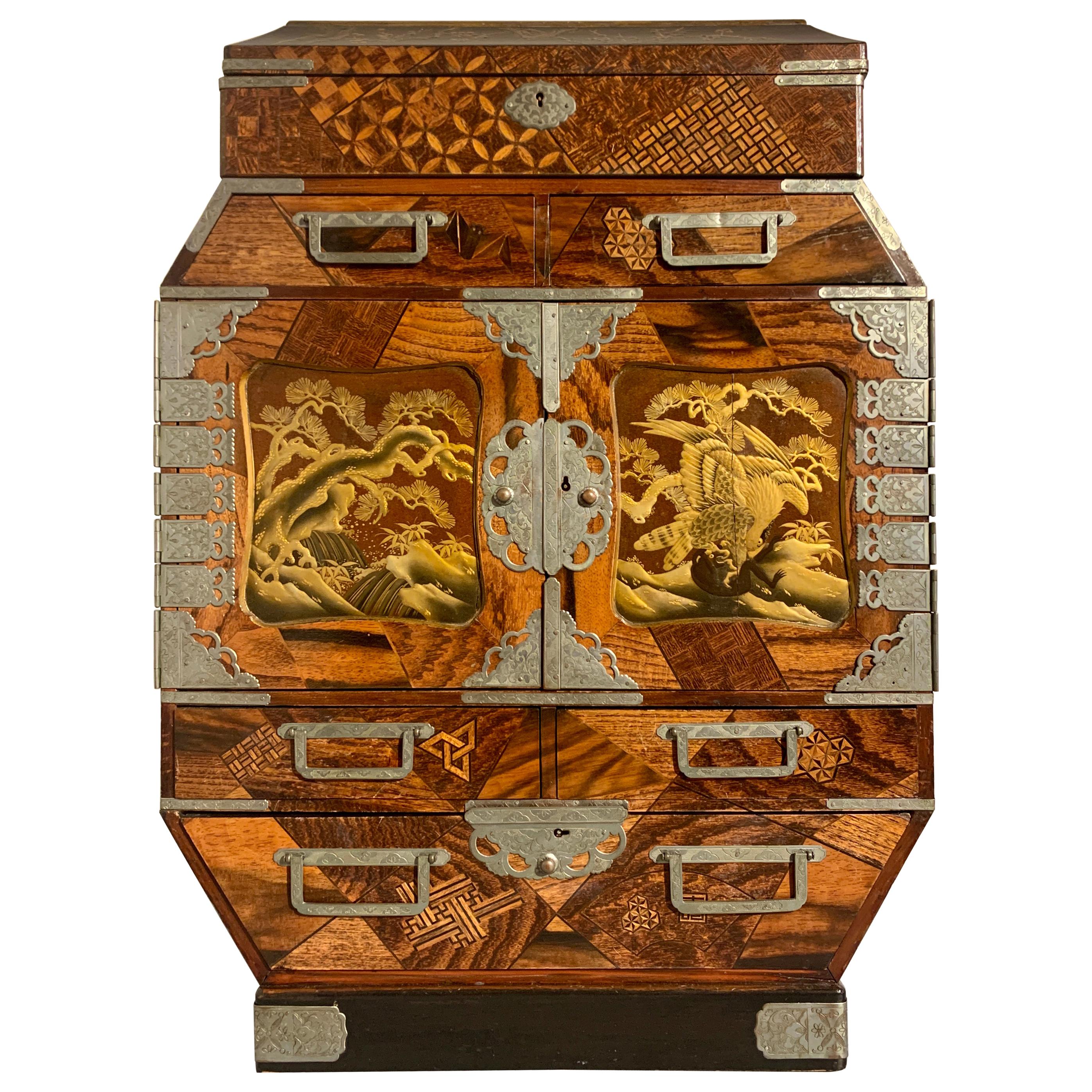Items Similar to Japanese Marquetry Shadona Etagere Cabinet, Meiji Period, Japan
Want more images or videos?
Request additional images or videos from the seller
1 of 17
Japanese Marquetry Shadona Etagere Cabinet, Meiji Period, Japan
About the Item
A spectacular Japanese yosegi zaiku marquetry etagere display cabinet, shadona, Meiji Period, circa 1880, Japan.
The display cabinet, called a shadona, of diminutive stature, and was probably meant to sit on a table or raised platform. The shadona is raised upon bracket feet, and designed with two open display shelves of varying heights, two sections closed with sliding doors, one section with a locking door (lock working and key present), three small graduated drawers, and one large drawer.
The shadona decorated in the yosegi zaiku technique, a marquetry technique using contrasting woods to create wonderful and intricate geometric patterns. In this case, the marquetry is especially dense and fine, featuring several types of contrasting woods, with the worked areas especially large. Each pattern is steeped in tradition and meaning.
The top and sides decorated with a mesmerizing pattern of overlapping circles, known as shippo, representing harmony and peace.
The back of the cabinet decorated with a checkered basketweave design set on a diagonal. The checkered design is known as ichimatsu, after the famous actor Ichimatsu Sadogawa who often wore this pattern, and is considered a symbol of prosperity.
The drawers, sliding doors, and locked door decorated with a stylized hemp leaf within a hexagon, a pattern known as asanoha, symbolizing growth, strength, and resilience.
The shadona also features geometric borders. One border used is the key fret border, known as raimon, representing rolling thunder. Another border used is the syagata, consisting of interlocking manji symbols, symbolizing longevity and eternity.
The shelves feature scattered, more open designs, contrasting nicely with the intricate geometry of the rest of the shadona.
While we have had several pieces of Japanese yosegi marquetry furniture and objects in the past, this is by far the most intricate and densely decorated one we have ever come across. A true masterpiece of design and workmanship.
- Dimensions:Height: 40 in (101.6 cm)Width: 30 in (76.2 cm)Depth: 14.75 in (37.47 cm)
- Style:Meiji (Of the Period)
- Materials and Techniques:
- Place of Origin:
- Period:
- Date of Manufacture:circa 1880
- Condition:Repaired: The locking door showing some replacement marquetry. One sliding door with evidence of repair. Wear consistent with age and use. Minor losses. Minor structural damages. Minor fading. The cabinet displays beautifully. The sliding doors and large drawer sometime stick a little. The top with some scratches and gouges.
- Seller Location:Austin, TX
- Reference Number:1stDibs: LU894733595242
About the Seller
5.0
Platinum Seller
These expertly vetted sellers are 1stDibs' most experienced sellers and are rated highest by our customers.
Established in 2001
1stDibs seller since 2010
308 sales on 1stDibs
Typical response time: 1 hour
- ShippingRetrieving quote...Ships From: Austin, TX
- Return PolicyA return for this item may be initiated within 7 days of delivery.
More From This SellerView All
- Large Japanese Marquetry Table Cabinet, Meiji Period, Late 19th Century, JapanLocated in Austin, TXA fine and unusually large Japanese table cabinet or jewelry chest with yosegi marquetry work and lacquer paneled doors, Meiji period, late 19th century, Japan. The oversized tab...Category
Antique 1890s Japanese Meiji Furniture
MaterialsBrass
- Japanese Lacquer Display Cabinet on Stand, Meiji Period, 19th Century, JapanLocated in Austin, TXA spectacular Japanese lacquer and porcelain inlaid display cabinet on stand, kazaridana, Meiji Period, late 19th century, Japan. The sumptuous kazaridana of traditional display cabinet form, with several shelves and enclosed spaces for display and storage. The cabinet decorated all over in beautiful maki-e lacquer against a dense nashiji ground and inset with blue and white Arita porcelain plaques. The front of the cabinet of asymmetric design, with two open display shelves at staggered heights, and several doors enclosing storage areas of various shapes and sizes, including one hinged corner door, two pairs of sliding doors, and one pair of hinged doors opening to reveal a rounded inset corner shelf. A pair of drawers below complete the cabinet. All supported on a separate tall fitted stand. The corner door decorated with a bold scene of a samurai warrior fighting a demon. This most likely depicts the warrior Watanabe no Tsuna battling the demon Ibaraki-doji at Rashomon gate, in which Watanabe no Tsuna attempts to help a young girl return home, carrying her on his back, only for the girl to turn into a demon, which he then must fight. The top pair of sliding doors with a scene of a man playing the sho, a Japanese mouth organ, along the banks of a river with a waterfall in the background. The bottom pair of sliding doors with a waterfall scene on one side, while a scholar lounges with his attendants on the other. The pair of hinged doors finely decorated with a pair of fully armored samurai. The two drawers wonderfully decorated in the kodaiji style with a stream of rushing water and various plants and grasses. The cabinet is decorated in the round, with the top, sides, and base of the cabinet decorated with various scenes of flowers and birds, and inset with blue and white Arita porcelain plaques in the form of traditional fan. The fans painted...Category
Antique 1880s Japanese Meiji Lacquer
MaterialsPorcelain, Softwood, Lacquer
- Japanese Sea Captain's Chest, Funa Tansu, Keyaki and Iron, Meiji Period, JapanLocated in Austin, TXA simple and elegant Japanese sea chest, funa tansu, crafted of keyaki wood with iron fittings, mounted on a modern iron stand, Meiji Period, dated 1882, Japan. This Japanese sea ch...Category
Antique 1880s Japanese Meiji Furniture
MaterialsIron
- Early 20th Century Meiji Period Japanese Export Center Table with DragonsLocated in Austin, TXA powerfully carved Japanese export dragon center table, Meiji Period, early 20th century. Made for the export market, the rectangular table features a...Category
Early 20th Century Japanese Meiji Center Tables
MaterialsSoftwood
- Chinese Peranakan Inlaid Hardwood Pagoda Display Cabinet, Early 20th CenturyLocated in Austin, TXAn impressive pagoda form carved hardwood display cabinet with bone and boxwood inlay, crafted for the Peranakan (Straits-Chinese) community in Southeast Asia, mostly likely Malaysia, Indonesia, or Singapore, early 20th century. The large display cabinet with four wide open shelves for display, set on four clawed feet, and surmounted by a peaked roof topped by a tiered pagoda with carved figures to the interior. A further set of pagodas with figures adorns each corner. The peaked roof decorated with a pair of magnificent phoenixes in flight flanking a large peony spray and a roundel featuring the goddess Magu and an attendant. The decoration of carved and inlaid boxwood. Clouds of carved bone scattered throughout. The sides of the roof each with a pair of sinuous dragons among clouds, a "shou" (longevity) medallion between them, all of carved and inlaid boxwood. The sides of the cabinet decorated with images of carved and inlaid boxwood birds and flowers - the left side with peony, the right side with chrysanthemum. The roof with a carved and pierced gallery below featuring auspicious animals and fruit...Category
Vintage 1910s Asian Chinoiserie Furniture
MaterialsBone, Hardwood, Boxwood
- Chinese Export Coromandel Lacquer Cabinet on Stand, Mid-19th Century, ChinaLocated in Austin, TXA delightful Chinese coromandel brown lacquer cabinet on stand, made for the export market, early to mid-19th century, China, presented on an early 20th century custom fitted stand. The gem of a cabinet is fitted with doors and drawers, and decorated on all sides. The top, back and sides with lacquer painted scenes of birds and flowers. The front of the cabinet featuring a pair of stunning coromandel doors carved with a shanshui (mountain and water) landscape scene, complete with temples and pagodas, boats and bridges, and figures, all set against craggy mountains shrouded in clouds and rippling water. The cabinet mounted with brass hinges and lock plates (key included) and a pair of carrying handles. Opening the doors reveals eleven wondrous black lacquer drawers...Category
Antique Mid-19th Century Chinese Chinese Export Furniture
MaterialsBrass
You May Also Like
- Japanese Carved and Lacquered Shibayama Cabinet, Meiji PeriodLocated in San Francisco, CAAn elaborate and finely detailed carved wood, and gold lacquered Shibayama cabinet (Chigaidansu). Having beautifully applied semi-precious stone and ...Category
Antique 19th Century Japanese Meiji Furniture
MaterialsMother-of-Pearl, Wood
- Japanese Meiji Period Kanto Style Kiri Wood Kitchen Cabinet with Sliding DoorsLocated in Yonkers, NYA Japanese Meiji period kiri wood two-part kitchen cabinet in the Kanto style with sliding doors, parchment paper and drawers. Created in Japan during the Me...Category
Antique Late 19th Century Japanese Meiji Cabinets
MaterialsWood, Parchment Paper
- Japanese Tansu Storage Cabinet with Sliding Doors, Meiji Period, 19th CenturyLocated in Savannah, GALarge Two Section Japanese Kitchen Tansu, Late 19th Century. Interior bottom section has been modified to accommodate a TV. Part of the back bot...Category
Antique Late 19th Century Japanese Meiji Cabinets
MaterialsElm
- Large Japanese Meiji Period 19th Century Futon Tansu Cabinet with Iron HardwareLocated in Yonkers, NYA large Japanese Meiji period two-piece futon tansu cabinet from the late 19th century, with original iron hardware. Created in Japan during the second hal...Category
Antique 19th Century Japanese Meiji Cabinets
MaterialsIron
- Rare and Important Japanese Meiji Period Shadona, circa 1890Located in Brighton, SussexA Japanese hardwood shodana with inlaid and lacquer decoration, Meiji Period 1868-1912, by Shoso Kosen, bearing two character signature and red seal, with various shelves, cupboards,...Category
Antique Late 19th Century Japanese Furniture
MaterialsHardwood, Lacquer
- Japanese Tansu Storage Cabinet with Sliding Doors, Meiji PeriodeLocated in Kastrup, DKA Japanese Meiji period two-section tansu cabinet (also known as Mizuya Dansu) crafted in pine and elm burl. The top section consist of sliding doors and drawers in elm wood. Lower ...Category
Antique Late 19th Century Japanese Meiji Cabinets
MaterialsIron
Recently Viewed
View AllMore Ways To Browse
Antique Japanese
Japanese Antique Japanese
Japanned Antique
Japanese Antique Furniture
Japanese Furniture Antique
Japanned Antique Furniture
Japanese Meiji Furniture
Antique Marquetry Furniture
Meiji Period Japan
Asian Symbol
Marquetry Art
Antique Door Lock
Japanese Art Tables
Circa Meiji Japanese
Japanese Doors
Asian Inlay Furniture
Meiji Wood
Meiji Wood Furniture





